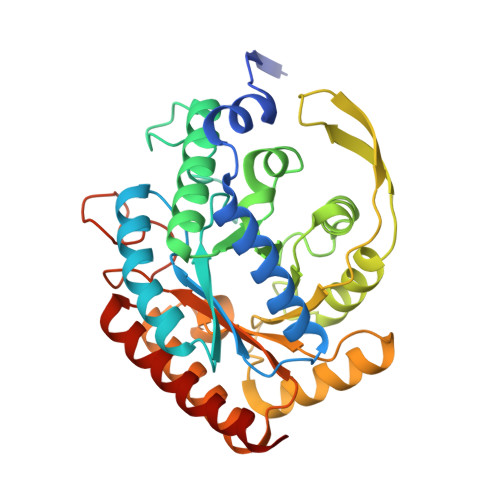Neisseria meningitidis expresses a single 3-deoxy-d-arabino-heptulosonate 7-phosphate synthase that is inhibited primarily by phenylalanine.
Cross, P.J., Pietersma, A.L., Allison, T.M., Wilson-Coutts, S.M., Cochrane, F.C., Parker, E.J.(2013) Protein Sci 22: 1087-1099
- PubMed: 23754471
- DOI: https://doi.org/10.1002/pro.2293
- Primary Citation of Related Structures:
4HSN, 4HSO, 4IXX - PubMed Abstract:
Neisseria meningitidis is the causative agent of meningitis and meningococcal septicemia is a major cause of disease worldwide, resulting in brain damage and hearing loss, and can be fatal in a large proportion of cases. The enzyme 3-deoxy-d-arabino-heptulosonate 7-phosphate synthase (DAH7PS) catalyzes the first reaction in the shikimate pathway leading to the biosynthesis of aromatic metabolites including the aromatic acids l-Trp, l-Phe, and l-Tyr. This pathway is absent in humans, meaning that enzymes of the pathway are considered as potential candidates for therapeutic intervention. As the entry point, feedback inhibition of DAH7PS by pathway end products is a key mechanism for the control of pathway flux. The structure of the single DAH7PS expressed by N. meningitidis was determined at 2.0 Å resolution. In contrast to the other DAH7PS enzymes, which are inhibited only by a single aromatic amino acid, the N. meningitidis DAH7PS was inhibited by all three aromatic amino acids, showing greatest sensitivity to l-Phe. An N. meningitidis enzyme variant, in which a single Ser residue at the bottom of the inhibitor-binding cavity was substituted to Gly, altered inhibitor specificity from l-Phe to l-Tyr. Comparison of the crystal structures of both unbound and Tyr-bound forms and the small angle X-ray scattering profiles reveal that N. meningtidis DAH7PS undergoes no significant conformational change on inhibitor binding. These observations are consistent with an allosteric response arising from changes in protein motion rather than conformation, and suggest ligands that modulate protein dynamics may be effective inhibitors of this enzyme.
Organizational Affiliation:
Biomolecular Interaction Centre and Department of Chemistry, University of Canterbury, Christchurch, New Zealand.
















